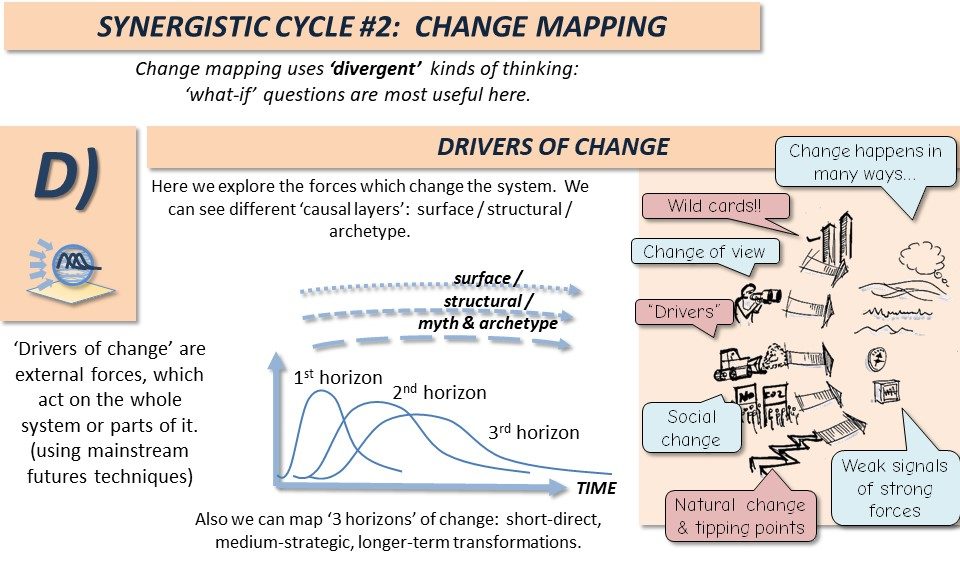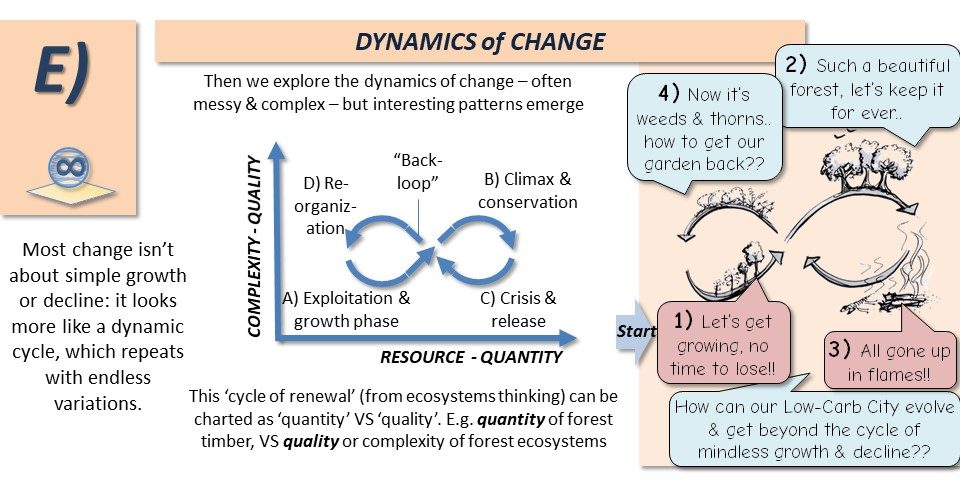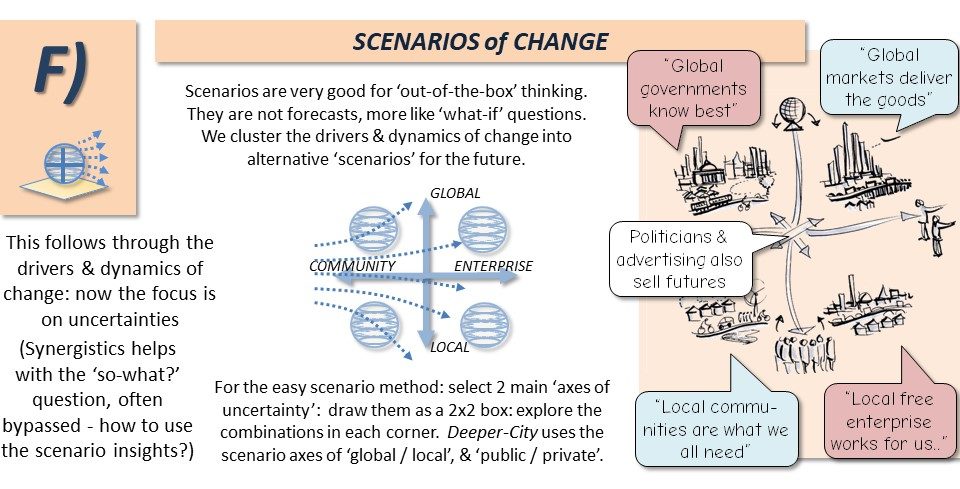Toolkit 2 – Secanrios
Change mapping centres on ‘divergent’ thinking, which spins off in different directions, some creative and some destructive: ‘what-if’ questions are the ones to raise.
Step (D): Drivers of change
Futures thinkers often start with the ‘drivers of change’, including external forces, internal forces, and compound effects from a complex inter-connected system. The crystal mind-ball on the left is like a prism which refracts the changes onto ‘3 horizons’. Horizon 1 is for shorter term tangible effects: Horizon 2 is about medium term strategic thinking: and Horizon 3 is about wider transformations (similar but not the same as the 1-2-3.0 model of co-evolution).
A conventional futures method would arrange the long list of drivers into simple categories of ‘probability’ and ‘impact’. In contrast a synergistic approach looks for more inter-connected system-wide perspectives, as the picture on the right: wild cards, changes of thinking, intentional social change, unplanned natural change, all seem to overlap and intersect.
For Low-Carb housing: population change & economic growth are obvious drivers of change. So are changes in domestic technology and social technology: with effects on lifestyles, mobilities, housing tenures, housing finance etc. Meanwhile don’t forget the ‘archetypes’… a house is a mythic object, but not as we knew it.

Step (E): Dynamics of change
System change is not always about growth, but is often more about cycles. Here we draw on the idea of adaptive renewal or ‘panarchy’ in ecological systems and modelling. A typical ‘phase-space’ diagram shows a “Y-axis” of system potential / quantity (biomass, carbon etc): and an “X-axis” of system complexity / quality. The typical cycle starts with a phase of growth and exploitation, where both quantity and quality increase, heading towards a ‘climax’ condition. Sooner or later there is a crisis such as a forest fire or flood: there follows a ‘back-loop’ of re-organization, where a different system is reconstructed: eventually this sets the conditions for a new cycle of exploitation. This concept from ecological systems can be very useful for other domains: cities, economies, technologies and so on.
This gets more involved with multiple-layer systems such as cities. It’s more likely that different domains – social, technical, economic and so on – may be at different points on the dynamic cycle. There are interesting lessons for practice: urban planning for instance, tends to focus just on the growth phase, and hasn’t often got the capacity or mindset to manage the whole cycle. We can also can look for multiple cycle effects: Manchester’s post-industrial split economy, has a city-centre strand in a growth phase while peripheral areas are in a regrouping phase, while local governance is in a financial crisis and political opportunity.
Low-Carb housing could be interesting – we could build a load of houses to meet demand, and the right people could come to live in them – then something happens, like a financial crisis and industrial shrinkage – our houses are empty and derelict – then the gentrifiers move in, but now with a rising market the locals can’t afford to live in ‘their’ town.

Step (F): Scenarios for change
Here are the drivers of change, again with external and internal, this time with uncertainties all around. The uncertainties of the drivers lead to many more uncertainties on their impacts. To make sense, we can cluster both drivers and impacts into alternative ‘scenarios’. Scenarios aren’t forecasts, more like a series of ‘what-if’ questions, structured in a way that is useful for following up. The scenario axes shown here are used through the pathways book, i.e. ‘global-local’ and ‘public-private’. These originated with the IPCC ‘SRES’ scenarios in 2001, and used in many projects since. Many other combinations are possible, but these represent a good starting point to explore alternative social, technical, economic and political futures.
A forward-looking scenario method is highlighted by experiences of scenario workshops. Often there are great aspirations for a Low-Carb city or similar visions and goals, but huge gaps between aspiration and reality. The synergistic approach can help with the next question – ‘so-what’ – how to use the scenarios to link present and future in a practical way. To do this we bring in the next stage of Synergy Mapping. Then we can compare, a linear growth-type scenario, with a ‘co-evolutionary’ scenario, where change comes with synergistic collective intelligence.
Low-Carb housing has many possibilities: a higher level public sector could organize everything – or maybe the global corporate will own all housing assets and lease them to us? There are alternatives – local private firms could build, sell or rent our houses: or indeed, local mutual societies, cooperatives or savings institutions could do this (as the 19th century).

